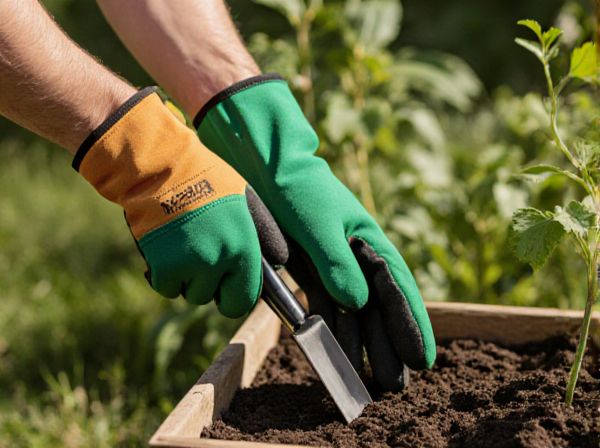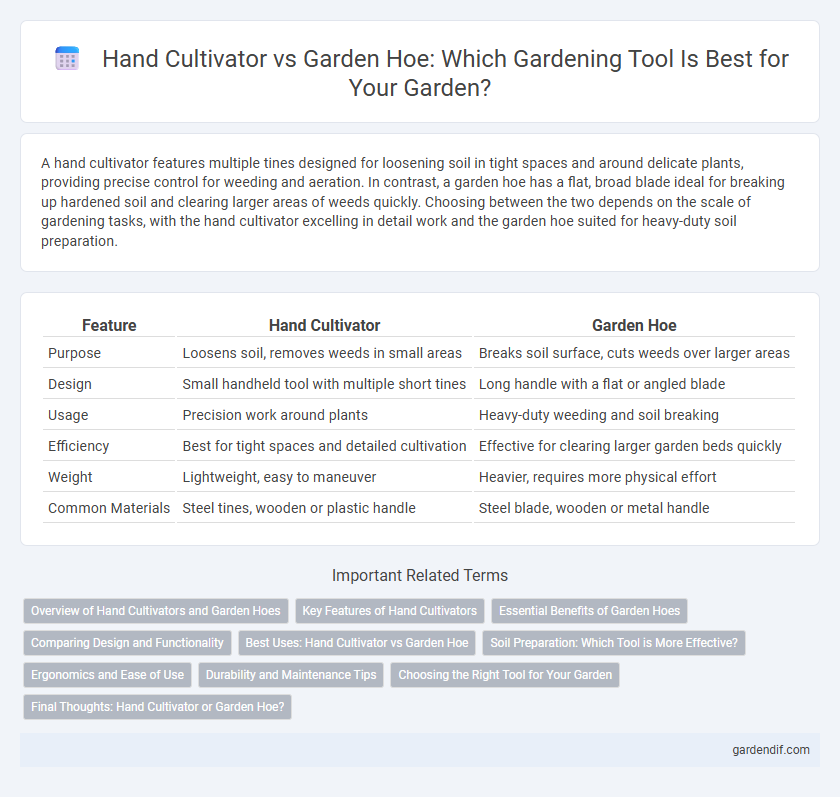
Hand cultivator vs Garden hoe Illustration
A hand cultivator features multiple tines designed for loosening soil in tight spaces and around delicate plants, providing precise control for weeding and aeration. In contrast, a garden hoe has a flat, broad blade ideal for breaking up hardened soil and clearing larger areas of weeds quickly. Choosing between the two depends on the scale of gardening tasks, with the hand cultivator excelling in detail work and the garden hoe suited for heavy-duty soil preparation.
Table of Comparison
| Feature | Hand Cultivator | Garden Hoe |
|---|---|---|
| Purpose | Loosens soil, removes weeds in small areas | Breaks soil surface, cuts weeds over larger areas |
| Design | Small handheld tool with multiple short tines | Long handle with a flat or angled blade |
| Usage | Precision work around plants | Heavy-duty weeding and soil breaking |
| Efficiency | Best for tight spaces and detailed cultivation | Effective for clearing larger garden beds quickly |
| Weight | Lightweight, easy to maneuver | Heavier, requires more physical effort |
| Common Materials | Steel tines, wooden or plastic handle | Steel blade, wooden or metal handle |
Overview of Hand Cultivators and Garden Hoes
Hand cultivators feature multiple curved tines designed for loosening soil, aerating, and uprooting weeds in small garden beds, offering precision and ease of use in confined areas. Garden hoes have broad, flat blades ideal for breaking up larger soil surfaces, shaping soil, and cutting weeds with a pushing or chopping motion. Both tools are essential for effective soil management but serve distinct purposes based on garden size and task requirements.
Key Features of Hand Cultivators
Hand cultivators feature multiple curved tines designed for loosening soil and aerating small garden beds, offering precise control for weeding and soil preparation. Unlike garden hoes, hand cultivators are compact and lightweight, making them ideal for delicate tasks around plants without causing damage. Their ergonomic handles reduce hand fatigue, enhancing effectiveness during extended gardening sessions.
Essential Benefits of Garden Hoes
Garden hoes provide essential benefits for soil aeration and weed control, enhancing plant growth by breaking up compacted soil effectively. Their sturdy design allows for efficient removal of deep-rooted weeds, reducing the need for chemical herbicides. Compared to hand cultivators, garden hoes cover larger areas quickly, making them ideal for maintaining expansive garden beds.
Comparing Design and Functionality
A hand cultivator features multiple curved tines designed for loosening soil and aerating small garden areas, promoting root health and weed control. In contrast, a garden hoe typically has a flat, broad blade optimized for chopping, shaping soil, and removing weeds on larger surfaces. The hand cultivator's ergonomic handle and tine arrangement allow precision work in tight spaces, whereas the garden hoe's sturdy blade and long handle provide leverage for breaking tough ground and edging.
Best Uses: Hand Cultivator vs Garden Hoe
A hand cultivator excels in aerating soil and removing small weeds in tight garden beds, making it ideal for precise, detailed soil care. Garden hoes are best suited for breaking up larger soil areas, shaping garden rows, and cutting through tougher weeds efficiently. Choosing between these tools depends on the scale of the gardening task and the type of soil preparation required.
Soil Preparation: Which Tool is More Effective?
Hand cultivators excel in aerating soil and breaking up small clumps, ideal for precision work in raised beds and tight spaces. Garden hoes are more effective for initial soil preparation, efficiently chopping weeds and loosening larger areas of compacted soil. Choosing between the two depends on the scale of the garden and the depth of soil cultivation required for optimal plant growth.
Ergonomics and Ease of Use
Hand cultivators feature lightweight designs with ergonomic handles that reduce wrist strain during prolonged use, making them ideal for precision weeding and soil aeration. Garden hoes typically have longer shafts, which allow for upright posture and less bending, minimizing back discomfort over extended periods. While hand cultivators offer better control in tight planting spaces, garden hoes provide greater leverage for breaking harder soil with less effort.
Durability and Maintenance Tips
Hand cultivators made of high-carbon steel offer superior durability and resist rust, ensuring long-lasting performance in tough soil conditions. Garden hoes with forged steel blades also provide strength but often require regular cleaning and occasional blade sharpening to maintain efficiency. To extend the lifespan of both tools, oiling metal parts and storing them in a dry place prevents corrosion and wear.
Choosing the Right Tool for Your Garden
Choosing the right garden tool depends on the task: hand cultivators excel at soil aeration and weed removal in tight spaces, while garden hoes are more effective for breaking up larger soil areas and creating furrows. Hand cultivators feature multiple prongs that loosen soil delicately around plants without causing damage, ideal for flower beds and vegetable gardens. Garden hoes have broader, flat blades designed for heavy-duty soil turning and weed cutting, making them suitable for large plots and preparing planting rows efficiently.
Final Thoughts: Hand Cultivator or Garden Hoe?
Choosing between a hand cultivator and a garden hoe depends on the scale and precision of your gardening needs; hand cultivators excel in small, delicate garden beds for aeration and weed removal, while garden hoes offer efficiency for larger areas and tougher weeds. Both tools enhance soil health and plant growth but suit different tasks--hand cultivators provide detailed control, and garden hoes deliver broader coverage. Ultimately, the best tool complements your garden size and maintenance style for optimal soil cultivation.
Hand cultivator vs Garden hoe Infographic

 gardendif.com
gardendif.com